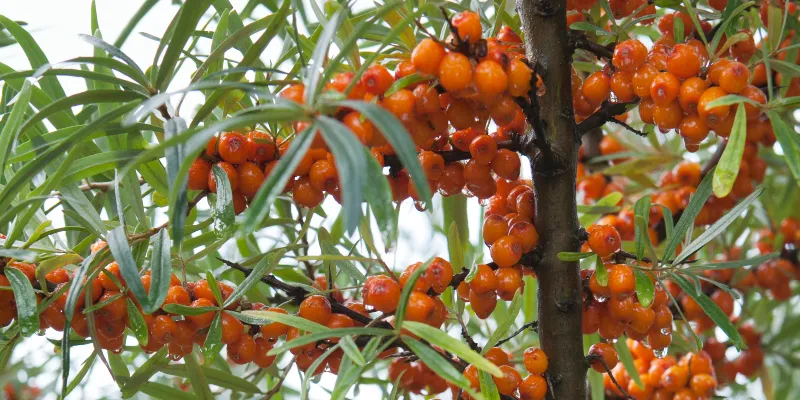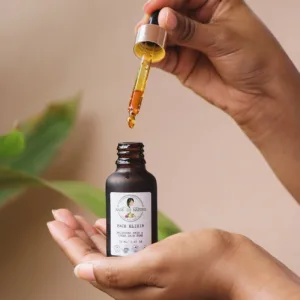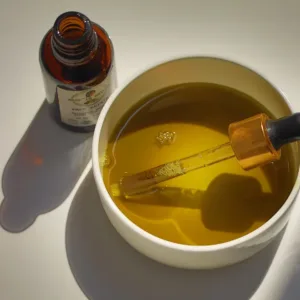
Sea Buckthorn
Synonyms: Sallow Thorn
Scientific Name: Hippophae rhamnoides L.
Family: Elaeagnaceae
Habitat
Europe, Near East
Constituents
Vitamin C, provitamin A, B complex vitamins, particularly vitamin B12, vitamin E, flavonoids, minerals, fruit acids, palmitoleic acid, sterols, essential fatty acids
Description
One could be forgiven for thinking that this is a plant that only occurs in Asia. The elegant, silvery-white, needle-like leaves and bright yellow to orange fruits do give sea buckthorn a rather exotic appearance. And there is some truth in the assumption, too, as the shrub is said to have come to Europe from Tibet 17,000 years ago with the ice age. But now it has made a home for itself in Europe where it can be found growing on sand dunes, on the banks of rivers and streams and on sunny slopes. The shrub, which can reach a height of 5 metres, has a main root which reaches deep into the earth and from which it sends out shallow side roots. This gives the sea buckthorn a good hold even on unstable ground and is the reason why it is often planted to stabilize embankments. There are male and female forms of the thorny shrub which carry small inconspicuous male or female flowers between March and May, before the leaves appear. The female flowers, which are only 3/16 (5 mm) across, give off a pungent odor of honey which attracts insects. However, this is not actually essential for fertilization as the wind carries the pollen from the male to the female plants. The closely packed, slightly hairy fruits, which can be as large as 3/8 (1 cm), ripen in August to September.
Uses
The juice pressed from the fresh berries is extremely rich in vitamin C and is used to support colds and fevers. A fatty oil obtained from the seeds is used in Russia for maintaining skin health. An oil obtained from the fruit flesh is said to help damaged skin. Sea buckthorn oil is also a popular ingredient of skin care products. Its combination of vitamin E and provitamin A provides antioxidant protection, supporting skin exposed to sun, dry air and wind. The oil supports skin renewal helping reduce the appearance of signs of aging. Rough, dry skin becomes supple again.
Interesting Facts
In ancient Greece sea buckthorn leaves and young shoots were used to give horses a particularly shiny coat. This is the origin of the scientific name Hippophae from hippos = horse and phaes = shiny. The botanical epithet rhamnoides = thorny describes the sea buckthorn’s thorny character.
Sea buckthorn has been known to man for a long time. More than a thousand years ago it spread through Mongolia and Russia and was used for many purposes. In an old recipe from Russia sea buckthorn oil is extracted from the juice of the berries with sunflower seed oil. This remedy was bottled and used on injured skin. Sea buckthorn was also used for treatment of hair loss. In France sheep were fed with sea buckthorn leaves to give their coats a particular sheen, too.
The seed coat of the sea buckthorn harbours a microorganism called Actinomyces which lives there in symbiosis with its host and produces amounts of the essential vitamin B12 such as are otherwise only found in meat. This makes sea buckthorn particularly important for vegetarians. The other constituents of sea buckthorn also appear to be present in particularly large amounts. The vitamin C content, for example, is nine time that of citrus fruits. People have always managed to combine these healthy properties of sea buckthorn with enjoyment. To this day, the vitamin rich berries are still used to make juices, syrups, preserves, jellies, liqueurs and brandies. Mixed with other fruits these delicacies become even more enjoyable because this softens the slightly acid taste of the sea buckthorn.
Sea buckthorn has been valued in Chinese and Tibetan medicine for 2000 years and is used particularly for restoring vitality. If you feel washed out, weak or tired sea buckthorn is the right thing to pep you up.
Sea buckthorn also lives in a beneficial symbiosis in the earth – with a ray fungus. The mycelium (mycorrhiza) lives in its roots where it binds nitrogen from the air. This bound nitrogen is taken up by the plant as a valuable fertilizer, the additional nutrition allowing sea buckthorn to thrive even on sandy soil.
The plant from another perspective
Sea buckthorn is born of the sun and likes brightness. The color of its berries, crowded together on the branches like numerous setting suns, is a supreme reflection of this preference. But sea buckthorn does not wither and dry out in the intensive rays of the sun. Yes, it contracts, has needle-like leaves, thorns and acid fruits, for example. But these fruits are also juicy and refreshing. Maybe this is what has made sea buckthorn the plant for helping dry skin.
The Plant in our Products
Bask in Nature’s products containing Ingredients from Sea Buckthorn Tree :



